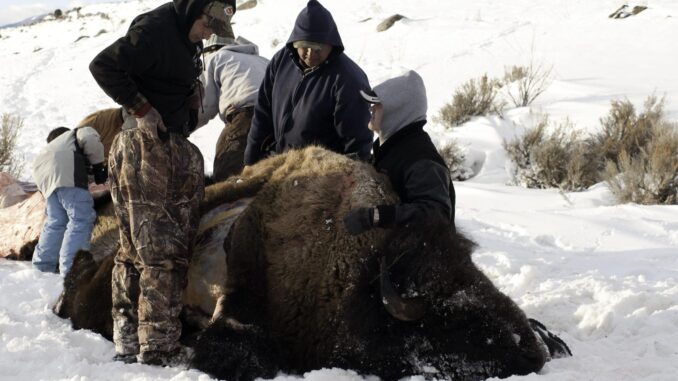
[ad_1]
Yellowstone National Park recently released its Final Bison Management Plan. It arbitrarily limits bison numbers through tribal hunting outside of the park and the transfer of public Yellowstone bison to Indian reservations.
The NPS Preferred Alternative 2 is better than the existing bison management but will continue the degradation of wild bison.
Alt. 3 is slightly better in that it would potentially allow for higher bison numbers in the park and less manipulation of the bison herd.

Nevertheless, all alternatives continue the ongoing trend towards domestication of Yellowstone’s globally significant wild bison.
PLAN ANTHROPOGENIC RATHER THAN BIOCENTRIC
The plan prioritizes human cultural desires over the need to protect the bison’s evolutionary and ecological role and future.

Yellowstone’s bison are the least manipulated and domesticated in the United States. The park bison herd has international significance, especially because NPS management favors maintaining evolutionary and ecological processes.
The Fish and Wildlife Service has recognized this significance, and it is currently reviewing whether Yellowstone bison should be given protection as a distinct population segment under the Endangered Species Act.
While the plan acknowledges preserving wild bison through evolutionary processes, it ultimately fails in this goal by setting a desired upper population limit of 7,000 bison. The bison number may increase, but if the 7000 animal number is approached, the NPS will capture bison for transfer to tribal reservations.
The worst part of the plan is its assumption that the Park has a legal obligation to grow bison so tribal members can shoot them outside of the park or should be distributing the public’s bison through transfer to tribal reservations, which effectively privatizes the public’s wildlife.

In other words, the plan is not about preserving the evolutionary and ecological of wild bison; rather, it is largely based on fulfilling a cultural rather than a biological preservation agenda.
I have some empathy for the Park’s dilemma. I suspect Yellowstone National Park would rather see bison permitted to migrate beyond the park border just as elk, mule deer, and other park ungulates do. However, the Park is under the gun from two political influences that, by “happy coincidence,” are united on the same outcome—the killing of the public’s wild bison.
MONTANA OPPOSITION TO WILD BISON
Most critics of the bison plan, particularly so-called conservation groups, focus on the Montana livestock industry. The Montana legislature opposes bison restoration in the state due to concerns about brucellosis transmission to domestic livestock.
Brucellosis is a bacterium that causes abortion in livestock. It can cause undulant fever in humans, but today, it is largely restricted to occupations like veterinarians and others who may handle infected animals.
Though as much as 60% of Yellowstone’s bison show antibodies against brucellosis, that does not mean they are infected with the disease, any more than I carry polio even though I have antibodies to it from childhood vaccinations.

There has been no documentation of brucellosis transfer from bison to domestic animals in the wild. On the other hand, 27 instances of brucellosis transfer to livestock by elk have occurred. Yet neither the state of Montana or Yellowstone NP restrict elk migration and movement out of the park.
The state policies ultimately creates the perimeters for federal agencies like the Custer Gallatin National Forest and Yellowstone National Park management. There is no reason why bison shouldn’t be migrating and even residing on adjacent national forest lands, but for the intransigence of the state of Montana.
PLAN POLICY FAVORS TRIBES AT THE EXPENSE OF WILD BISON
While Montana opposes restoring wild bison to public lands in the state, the biggest threat to Yellowstone’s wild bison comes from the tribes.
Sec. of Interior Haaland has ordered that tribes be given exceptional management authority over Yellowstone bison and encourages the privatization of public bison by transfer to the tribes. This has been implemented without any opportunity for public review and comment through a NEPA process.
Montana Wild Bison Restoration Council, Sage Steppe Wild, the Gallatin Wildlife Association, Roam Free Nation, and Alliance for Wild Rockies support the management of the park’s wildlife to preserve its ecological values, not as a “hatchery” to produce bison for tribal slaughter.
While the bison plan recognizes the evolutionary value of the park’s bison, it doesn’t translate into their public trust obligation to preserve the park’s bison from continued domestication and degradation.
PLAN SHORTCOMINGS
The plan is based upon the tribes’ assertion that they have treaty “rights” to kill animals on public lands outside of Yellowstone’s northern entrance by Gardiner, Montana. According to the tribes’ interpretation, specific tribes have the authority to shoot wildlife throughout the year and without limits other than those imposed by the tribes themselves.
No public lands agency, including the Montana Department of Fish and Wildlife, Custer Gallatin National Forest, and Yellowstone National Park, has control over tribal kills.
Since 2006, Indian Tribes, including the Confederated Salish and Kootenai Tribes of the Flathead Nation, Nez Perce Tribe, Confederated Tribes of the Umatilla Indian Reservation, Yakama Nation, Blackfeet Nation, Shoshone-Bannock of the Fort Hall Reservation, Northern Arapaho Tribe, and Crow Nation have slaughtered bison on national forest lands adjacent to the park.
Restraint has not been a hallmark of tribal bison kills. For instance, out of 1272 bison killed or removed from Yellowstone’s ecosystem in 2023, tribal members killed 1150 bison, more than 25% of the park’s bison herds, not to mention other wildlife like elk, bighorn sheep, and pronghorn.
However, whether these treaty rights are legitimate has never been tested in court. Yellowstone National Park refuses to examine the issue claiming it is beyond the scope of the bison plan—even as the agency repeatedly suggests the tribes have treaty rights without providing any evidence other than the assertions of the tribes.

Given the controversial nature of that, I can understand why anyone or any government agency would hesitate to question tribal authority.
The problem for those who advocate for wild bison is that nearly all conservation groups now put conservation of cultural goals over preservation of biocentric goals, especially if tribes are involved. At the same time, the livestock industry also wants bison numbers controlled.
The Montana Wild Bison Restoration Council, as well as others, assert that the tribes have no legal right to kill wildlife in this area. What is confusing to many is tribes do have legal treaty rights to hunt in other areas depending on the tribe’s original treaty wording, but I believe none have treaty rights to the lands near Gardiner.
Under the bison plan, if the population reaches 7,000 animals, the NPS will begin translocations. Photo George Wuerthner.For instance, the Final EIS bison plan suggests: “The NPS has committed to continue fulfilling its trust responsibilities (USDOI and USDA 2021) to American Indian Tribes by sustaining a large population of bison that supports hunter harvests outside the park and restoring more brucellosis-free bison to tribal lands.”
However, the NPS has no trust responsibility to the tribes; the Secretary of Interior Deb Haaland’s trust responsibility extends to real property or other assets that the Secretary holds on behalf of Indian Tribes or Indian allottees.
The Secretary’s ultimate responsibility is to all citizens of the United States and to the wildlife entrusted to public agencies to manage wildlife for the good of all, not just the benefit of a few. Without a lawsuit, the NPS has adopted an expansive and extra-legal definition of “Trust” on behalf of tribes but neglects its trust obligation for wildlife.
Everyone seems to ignore a specific Supreme Court decision called the conservation requirement. Supreme Court Justice William O. Douglas declared that if any tribal resource exploitation jeopardizes the future of any entity, the government has a duty to protect that plant or animal.
Given that Yellowstone’s bison have globally significant biological, ecological and evolutionary value, one could argue that excess removal and effective animal domestication jeopardizes these creatures’ long-term wildness.
Furthermore, there is the question as to whether capitulation to tribal interests is anti-democratic and racist in that the plan expressly gives tribal groups more authority over public lands management than the public.
As a result, the plan surrenders the Public Trust to a political interest group—namely, tribal governments.
It is important to note that tribal people are like citizens everywhere. Some support the bison slaughter, while others are appalled by it. Unfortunately, those voices are drowned out by those who want to make their personal desire to kill bison trump what is ultimately good for bison.
However, I hold my condemnation for the spineless and virtue signing by so-called wildlife/bison advocacy organizations like Defenders of Wildlife, Greater Yellowstone Coalition, National Parks and Conservation, and Buffalo Field Campaign, among others, who, instead of pressing for better treatment of the bison support tribal co-management because anthropogenic desires of tribal groups are more important to these organization than preserving wild bison.
This article by George Wuerthner was first published by The Wildlife News on 25 June 2024. Lead Image: Hunters gutting bison shot on Gallatin NF by Gardiner Montana. Photo George Wuerthner.
What you can do
Help to save wildlife by donating as little as $1 – It only takes a minute.
[ad_2]
Source link



Leave a Reply